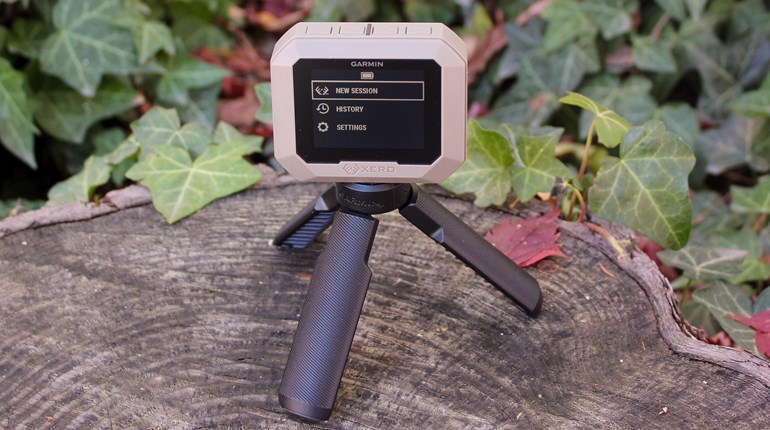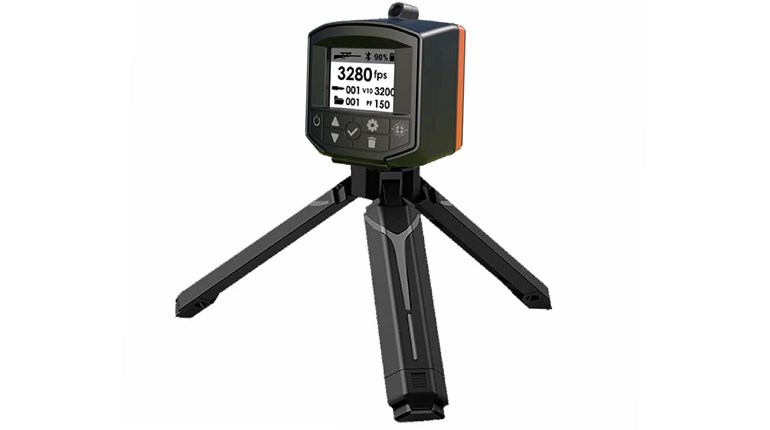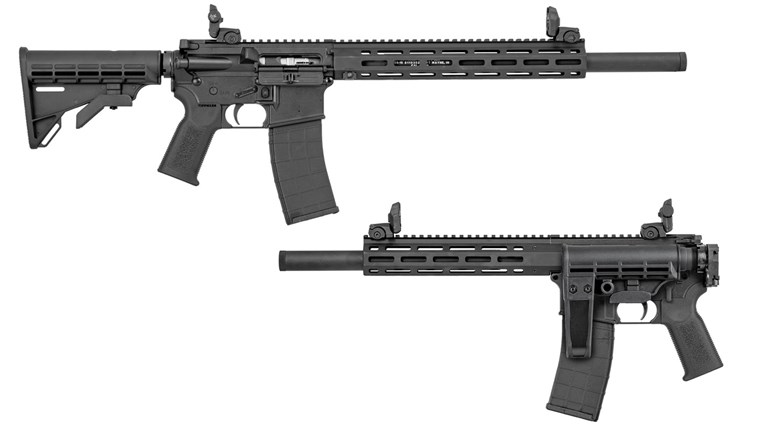
I know, I know. The term “game-changing” gets used so often that it’s practically become meaningless. A handgun now comes in flat dark earth? Game-changing! A rifle now has a molded polymer stock? Game-changing! It’s a term that has been diluted to near-irrelevancy now, so much so that I hesitate to use it even with regard to advancements that truly are game-changing.
Like the Garmin Xero C1 Pro chronograph, for example. For people that have to routinely record the velocity of their ammunition, whether a precision handloader crafting a long-range round, a competitor making sure their rounds make a certain power factor or, well, a gunwriter tasked with reviewing a firearm (which, in the case of Shooting Illustrated, means recording the ten-shot average velocity of three different ammunition types), setting up a chronograph and taking these measurements can be a time-consuming affair. With the new Garmin Xero C1 Pro, though, it has been dramatically simplified and shortened.
I understand not a lot of shooters will make use of a chronograph, so for the uninitiated, here’s a (very) quick primer. There are two basic types in use: those that use radar, and those that use screens. Even if you’ve never chronographed a single round, you may have seen someone at your local range set up a bizarre looking contraption with metal rods, overhanging screens and a small base typically attached to a tripod. More recent are radar-based chronographs, which have made the process easier by reading the Doppler shift of a round as it streaks down range (this is a gross over-simplification, I understand; the exact science gets all physics-y and it has been a long time since I thought about all that math … ).
The Xero C1 Pro is this second type and makes life even easier: it is placed next to your firearm, not downrange. This has two immediate benefits: First, you don’t have to call a cold range to walk down and setup/take down your chronograph. While a simple task, if you’re on a busy range it can take time and requires you call cold twice in a relatively short span. The second benefit is instantly apparent to anyone who, like me, has a confirmed chronograph kill to their credit. Since the Xero is NOT down range, it’s not in the line of fire and therefore extremely unlikely to be hit (I refuse to say never because, well, Murphy laughs…)
Setup is ridiculously easy: Pair the Xero with a smartphone to receive the data and you can record pretty much as much as you like (the device can hold 50 strings of up to 100 shots on its own, but is practically unlimited when sending data to a phone or laptop). Four buttons sit on top of the device: “OK” for confirming various choices, Power/return to turn the Xero on and off as well as to go back to the previous screen and up/down arrows for navigation. That’s it. With those buttons you toggle the Xero through the various options: Pistol/rifle/bow/airgun/other (yes, you can record the velocity of shotgun pellets, crossbow bolts, arrows, BBs, and just about any other projectile traveling faster than 100 fps). For handguns with typical handgun velocities, you shoot over the chronograph; for rifles you shoot next to the chronograph (within a foot or so; this is how it picks up your projectiles on a crowded public range).
 Here's how ridiculously easy the Garmin Xero C1 Pro chronograph is to use. First, power the Xero CI Pro on by pressing and holding the power button. The screen that pops up has exactly three options: New Session, History and Settings. History is, obviously, the previous sessions stored on the device and Settings changes the units, display color, data fields, etc. It’s the “New Session” that starts the actual chronographing. There are five choices: Rifle, Pistol, Bow, Air Rifle and Other; each section has its own subsections, it is up to your individual need which one you choose. Let’s go with pistol, just because. Pressing “OK” on the Pistol setting brings up two choices: 600 – 1,700 fps and 1,700 – 5,000 fps; here, you do need to have a rough idea of the velocity; the manufacturer’s numbers should be fine (i.e.; if you’re shooting a 115-grain 9 mm out of a 4-inch barrel pistol, choose the lower number). Once you’ve selected the velocity range, click “OK” and a diagram shows you where you need to place the muzzle for accurate readings. Press “OK” again and you’re ready to chronograph. It’s more involved to type out the procedure here than to actually do it by like an order of magnitude (not really; it’s just that “math” thing that I try to avoid)…
Here's how ridiculously easy the Garmin Xero C1 Pro chronograph is to use. First, power the Xero CI Pro on by pressing and holding the power button. The screen that pops up has exactly three options: New Session, History and Settings. History is, obviously, the previous sessions stored on the device and Settings changes the units, display color, data fields, etc. It’s the “New Session” that starts the actual chronographing. There are five choices: Rifle, Pistol, Bow, Air Rifle and Other; each section has its own subsections, it is up to your individual need which one you choose. Let’s go with pistol, just because. Pressing “OK” on the Pistol setting brings up two choices: 600 – 1,700 fps and 1,700 – 5,000 fps; here, you do need to have a rough idea of the velocity; the manufacturer’s numbers should be fine (i.e.; if you’re shooting a 115-grain 9 mm out of a 4-inch barrel pistol, choose the lower number). Once you’ve selected the velocity range, click “OK” and a diagram shows you where you need to place the muzzle for accurate readings. Press “OK” again and you’re ready to chronograph. It’s more involved to type out the procedure here than to actually do it by like an order of magnitude (not really; it’s just that “math” thing that I try to avoid)…
That’s it. You can record velocities while zeroing a scope without worrying about hitting a screen. You can accurately measure the velocity of a short-barrel revolver without concern that a tiny dip of the muzzle sends a round through the last screen of a very precise (and very expensive) Oehler screen, taking the entire device out of operation for the entire division (ahem). More importantly, you can set up, record velocities and finish up without ever getting off the bench. Truly game-changing. The close proximity of the device to the barrel (no greater than 15 inches) makes it extremely unlikely the device will pick up another shooter on a public range; I tested it on the NRA’s public range and acquired readings just fine; with the Garmin in the center of the roughly 3 (4?) foot wide bays it only picked up my handgun.
The Xero does this all from a little, included tripod and with a rechargeable internal battery. Garmin claims a battery life of six hours on a single charge, and I’ve used the Xero on multiple occasions before it even vaguely needed to be charged. I’ve found it to be pretty comparable in results to the Oehler Model 36 we have historically used for gathering velocity data, and while the Oehler is certainly more accurate, it’s hardly what anyone would call portable: Three screens and a computer are needed to accurately record data. It’s an amazing system, no question about it; there’s no practical way to set it up in the field, though.
Discussing the Xero with friends in the industry, an interesting question is brought up, and I genuinely don’t have an answer for it: How often do non-gunwriters need to chronograph ammunition? I have friends that are PRS competitors, and some of them will avail themselves of precise measurements taken from their competition rifle using the same ammo they’ll use in matches; I’ve also known competitive pistol shooters who want to be sure their reloads make a specific power factor. Outside of that, though, there’s a legitimate question as to who the target market might be.
I’ll make the argument – and here’s where the game-changing aspect comes in – that the Garmin Xero C1 Pro chronograph makes recording your ammunition velocity so easy that it might entice more shooters to start doing exactly that. Have a short-barreled carry gun and want to make sure your preferred ammunition will perform? If you have access to gelatin, you can do this; otherwise, you can ascertain the velocity of the round out of your pistol and compare it to the manufacturer. Hunter? Wouldn’t it be good to know that the ammunition you rely on to stop an animal in its tracks is hitting the desired velocity to accomplish this? Information is power, and you can glean a lot of information out of a reliable chronograph and the firearms and ammunition you use.
How easy is the Garmin Xero C1 Pro to use? Let me put it to you this way: As someone who has shot a chronograph before, I always approached getting readings with apprehension. No, that’s not true. I was scared silly. The thought of hitting another screen absolutely filled me with dread, and while I am always extremely careful to make sure I’m nowhere near the edges, there’s always the chance; I’ve shot some firearms with some, well, difficult triggers. With the Xero? I am chronographing for fun. That’s a sea-change in my attitude toward testing. It’s ridiculously easy and near impossible to hit the device; having the results on my smartphone mean I don’t have to worry that someone has used the last of the paper in the printer to which the Oehler is attached (ahem…). I have the results on my person when and if I need them, rather than trying to find the review online. The Xero has added so much more power to the analytical ability in testing firearms. And now, it’s fun rather than fear-inspiring. That’s nothing short of amazing. Game-changing, indeed.
The MSRP on the Xero C1 Pro Chronograph is $599, which admittedly is a bit more than the standard, metal-rod-and-screen outdoor chronographs available. It’s right in line, though, with other radar-based devices, and is the smallest and easiest to use of all that type of device I’ve tried. Other radar-based devices have been problematic on our test range—we have an 8-foot by 8-foot concrete box, and other devices have had trouble picking up the signal. Not the Xero. The only thing I’ll mention is that the Xero does take a few seconds to register each shot. If you try to shoot too quickly, it may miss a reading. Slow down and you’ll be fine.
One last bit, and this refers back to selecting the velocity range for your measurements. I was chronographing the Smith & Wesson model 1854 lever-action rifle in .44 Magnum, and using the velocity measurements on the box of ammo, I chose the “600 – 1,700 fps” setting at first. After three tries and no reading on the Garmin, it dawned on me that the 1,350 fps reading was most likely obtained with a handgun (and, hence, would be significantly faster out of a rifle). Changing the setting to “1,700 – 5,000” gave readings just fine. It’s generally not that much of an issue, but if you’re shooting something that might vary significantly due to barrel length (.22 Mag. and 5.7 mm, I’m looking at you here … ), it may require a little trial-and-error.
In any case, the Garmin Xero C1 Pro chronograph is a little device that punches far above its weight. Indoor, outdoor, public range or private; you can use it anywhere you can safely shoot. I’ve even recorded velocity readings while zeroing a scope on a rifle, that’s how convenient it is. If you do any chronograph work in your shooting endeavor, the Xero is an indispensable tool indeed.






































